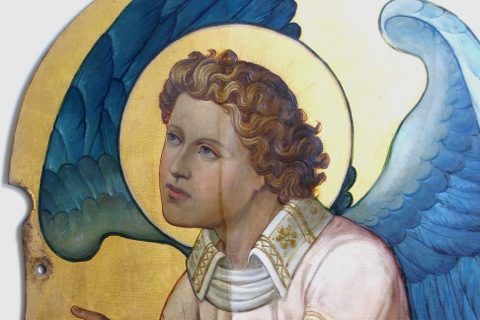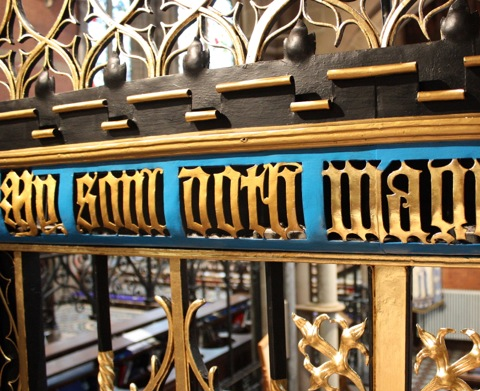Chancel Decorative Scheme at The Parish Church of St Mary the Virgin
 Founded in 1998 by David Everingham, the company has become established as one of the leading private conservation businesses in the north of England. The conservation of easel paintings in the Harrogate-based studio remains the core activity with clients including local authority museums and collections and privately owned paintings. The company has become increasingly involved in large scale projects in churches and historic building.
Founded in 1998 by David Everingham, the company has become established as one of the leading private conservation businesses in the north of England. The conservation of easel paintings in the Harrogate-based studio remains the core activity with clients including local authority museums and collections and privately owned paintings. The company has become increasingly involved in large scale projects in churches and historic building.
Reflecting the increasing application of scientific knowledge and analysis in conservation David’s background is in science, with a first degree in biochemistry. After completing an MA in the conservation of fine art David spent several years in museum conservation before entering private practice. Currently with four employees the business continues to grow and expand its repertoire of skills. A growing clientele includes:
Easel painting conservation for local authorities including Harrogate Borough Council, Barnsley Metropolitan Borough Council, North East Lincolnshire Council, Middleborough Institute of Modern Art (MIMA).
Church-based projects:
Bury Parish Church; conservation of oil-on-copper panels depicting episodes from the life of Mary; conservation of the reredos; conservation of wrought-iron screen.
St Michaels Funerary Chapel, Sheffield; conservation of Charles Eastlake decorative scheme
St Marys Church, Whitby; conservation of 18th century coat-of-arms
HISTORY OF THE CHURCH
Bury Parish Church of St Mary the Virgin is located at the highest point in Bury town centre. Although the present building is Victorian there has been a church on the site for over 1,000 years: in medieval times the west door would have looked out across the market place to the castle.
The steeple pre-dates the church, having been built in 1842. The church was designed a few years later by J S Crowther on a much grander scale and, with the nave now higher than the base of the spire, the two were cleverly joined by the addition of a narthex. This now houses a coffee shop and Christian bookshop open when the church is, on five days each week.
The highly decorative mosaic floor is by Minton.
The present church was consecrated on 2nd February 1876, having taken 5 years to build
THE CHANCEL SCHEME DEPICTING SCENES FROM THE LIFE OF THE VIRGIN
The chancel scheme was installed in 1888, dedicated by Sarah Openshaw in memory of Edward J. Hornby. The Scheme consists of four scenes from the life of the blessed virgin set within arches on the N, NE, SE and S walls of the chancel. The scenes are: The Annunciation, The Nativity, Temple Scene and The Adoration of the Magi. Each scene is made up of between 8 and 13 separate copper plates each of which is attached to the brick of the chancel wall. The attachments are in two forms: bolts with decorative heads at the edges of the plates and flat head screws, filled and painted to match painting detail, within the plates. Although the verso of the plates was not visible it was clear from traces of a green corrosion product that the metal is Copper was commonly used as a painting support from the 17th century onwards when rolling mill technology permitted the production of flat thin panels. Copper panels were prized for the smooth surface that facilitates very fine brushwork, and hence detail, as is demonstrated by these works. Copper panels also allow the artist to work from a dark background to create certain visual effects also evident in this series of paintings.
The panels are painted in oil in thin, multiple layers. The paintings were executed with a wide variety of pigment types including a range of earth colours (umbers, ochre’s, sienna’s), rich reds including alizarin crimson and vermilion, greens including viridian, oxide of chromium and possibly malachite, lead white, and several yellows. The artist would have had access to a range of synthetic pigments developed in the late nineteenth and early twentieth centuries. There are several panels where paint loss or damage has been caused either by mechanical damage (scratches and abrasion) or by the effects of water or spillage of other liquids.
The scheme was examined by David Everingham initially in 2007 when concern had been raised about the abraded appearance of the gilded background of the panel depicting the Adoration of the Magi. This proved to be the tip of the iceberg, closer examination revealing numerous conservation issues. The scheme was covered with a layer of surface dirt, both loose accretions of dust and other particulate matter, and firmly adhered surface dirt.
Candle burning has been intermittent in the Church but had probably contributed to the accretions of surface dirt. The scheme has also probably acquired surface dirt as a consequence of high pollution levels in the city centre location, especially in the late nineteenth and first half of the twentieth century during the peak of industrial activity.
The scheme also had a profoundly yellowed varnish, typical of the naturally occurring organic resins used for this purpose. Additionally the paintings exhibited numerous scratches and abrasions, corrosion of the copper panels, and other instances where original gilded surfaces were damaged. A decision was made in 2008 to undertake a comprehensive conservation program to conserve the panels.
The program of conservation of the panels included removing the surface deposits, removing the discoloured varnish, re-gilding areas of abrasion, retouching damaged surfaces and re-varnishing with a modern, hard-wearing varnish. All the materials and techniques were selected according to strict conservation principles with the long-term well-being of the panels in mind. Two of the most important conservation principles, the reversibility of treatments, and adhering as far as possible to the original intentions of the artist, were observed at all times.
The photographs, especially those taken during cleaning, are testimony to the dramatic improvement in the appearance of the panels. Dull greys turned into brilliant whites, browns into rich reds and the gilded surfaces reflected light with the brilliance of freshly applied gold leaf.
The Reredos
The Edwardian reredos, a magnificent structure carved in oak with the Epiphany as its central feature, had also accumulated significant surface dirt deposits. Although not original to the church, it now embellishes the existing decorative scheme, but was looking tired compared to the newly conserved oil-on-copper panels.
After removal of surface dirt and minor repairs, the original tonal values of the reredos were restored, and it now sits proudly as the centrepiece of the chancel scheme. The pelican atop the reredos, plucking blood from her breast to feed her young in a symbol of piety, now stands out in brilliant white against the stonework behind.
 The Chancel and South Chapel Screens
The Chancel and South Chapel Screens
History
The larger wrought-iron screen separating the nave from the chancel is an imposing structure at 25 feet high and 40 feet wide. Dedicated to the memory of Sarah Openshaw on her death in 1899 it is part of the Crowther-design. It consists of vertical elements supporting a central arch with three smaller arches to either side. Surmounting the arches is a repeating Fleur-de-Lys motif, with a secondary Fleur-de-Lys motif above.
Appropriately, the Fleur-de-Lys is an attribute of Mary, with connotations of female virtue and spirituality. The three petal structure may also be a representation of the Holy Trinity, giving double significance in the context of St Mary’s at Bury. The centrally located cross dominates the structure at over 40 feet high. In between the main structural elements are the decorative elements, scrolls, whorls, vine and rose motif, and further Fleur de Lys.
The real jewel in the crown, and probably the finest piece of craftsmanship in the entire church, is the Sir Giles Gilbert Scott-designed wrought-iron screen and gate for the south chapel. Sir Giles Gilbert Scott was commissioned to design the screen at the same time as his work on Liverpool Cathedral, and it is clear that the projects share similar design elements. With superbly crafted spandrels, palmettes and leaf motifs and a running border of fine tracery, almost art nouveau in style, the screen is a masterful demonstration of design and craftsmanship. The only thing was the dreadfully dull gold-painted surfaces that were covering earlier gilding.
Proposal for Re-gilding
After the conservation of the copper panels in the chancel the large wrought-iron chancel screen and the smaller, more delicate south-chapel screen looked profoundly tired and in need of some attention. Likewise, the wrought-iron altar screen required treatment. Some of the older parishioners had remarked that elements of the screen painted in a now dull paint were once gleaming with genuine gold leaf. Records of this were nowhere to be found, but a programme of selective re-gilding was proposed. With input from David and Reverend Dr. John Findon, Nick Rank, senior architect with Buttress, Fuller Allsop based in Manchester, proposed a new design for the gilding of the screen. The design for the Giles Gilbert Scott-designed south chapel screen was to remain the same, gold leaf replacing the drab, gold-painted areas.
Whereas water-gilding is suited to picture frames and other surfaces where a high burnish is required, oil-gilding is generally better suited to wrought-iron. Once the surface to be gilded is cleaned and dust-free, gold size, a modified linseed oil, is applied in stages to cover the entire area. Drying times for gold size varies from a few minutes to several days. Apart from the skill in applying the gold, the key to success is to apply leaf only when the size has dried to its optimum receptivity. Too early and the gold will disintegrate, too late and the leaf will simply not take. Planning ahead, often several days and weeks, was critical. Knowing how much size to apply that can be leafed in a particular day was essential to get the best results and to minimise wastage. Adding to the demands of this particular project was the complex nature of the wrought-iron to be gilded.
With undulating surfaces and tight scrolls, applying leaf in solid blocks required extraordinary patience, especially 40 feet above ground on a tower scaffold.
The results of gilding have been spectacular. Where once the surfaces were dull and uninspiring, the wonderful reflectance of the gold surfaces now illuminates the aisles of St Marys. The project has been immensely satisfying, and the team from David Everingham Conservation leave with some regret after many months on site.
Thanks go to Flo, the church warden who looked after us so well, to Reverend Findon, whose presence and remarkable knowledge have been very much appreciated, and particularly to Derek Calrow for his extraordinary generosity.
For more information about David and his work visit www.everinghamconservation.co.uk













